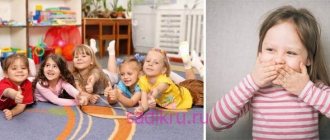Presentation on the topic: “Theatrical activities in kindergarten”
Kostanay kalasy akimdiginin “Kostanay kalasy akimdiginin more than 3 bobekzhai-bakshasy” Memlekettik kommunaldyk kazynalyk kasiporny.
State communal government enterprise "Nursery-garden No. 3 of the akimat of the city of Kostanay of the education department of the akimat of the city of Kostanay"
Theatrical activities in kindergarten
Prepared by: teacher
Kusherbaeva Z.B.
“The theater is a magical land in which a child rejoices while playing, and through play he learns about the world”
S.I. Merzlyakov
Dramatic play
is creative play. It represents the acting out of literary works (fairy tales, short stories, specially written dramatizations). The heroes of literary works become characters, and their adventures and life events, changed by children's imagination, become the plot of the game.
Children's whole life is filled with play. Every child wants to play their role. Teaching a child to play, take on a role and act, while at the same time helping him gain life experience - theater helps to achieve all this.
Theatrical activities in kindergarten
This is a good opportunity to reveal the creative potential of the child and nurture the creative orientation of the individual. Children learn to notice interesting ideas in the world around them, embody them, create their own artistic image of a character, they develop creative imagination, associative thinking, speech, and the ability to see unusual moments in the ordinary. Theatrical activities help the child overcome timidity, self-doubt, and shyness. Thus, theater helps the child develop comprehensively.
Theatrical activities
Bring variety to a child's life. It gives joy to the child and is one of the most effective ways of corrective influence on the child, in which the principle of learning is most clearly manifested: learn by playing.
In the process of theatrical games: - Children’s knowledge about the world around them expands and deepens.
— Mental processes develop: attention, memory, perception, imagination. — Various analyzers are developing: visual, auditory, speech, motor. — Vocabulary, speech structure, sound pronunciation, coherent speech skills, tempo, expressiveness of speech, and the melodic and intonation side of speech are activated and improved. — Motor skills, coordination, smoothness, switchability, and purposefulness of movements are improved. — The emotional-volitional sphere develops, children become familiar with the feelings and mood of the characters, and master ways of expressing them externally. — Behavior correction is taking place. — A sense of collectivism, responsibility for each other develops, and the experience of moral behavior is formed. — The development of creative, search activity, and independence is stimulated.
Types of dramatization are: Games-imitation of images of animals, people, literary characters;
Role-playing dialogues based on text; Staging of works; Staging performances based on one or more works; Improvisation games with the acting out of a plot (or several plots) without prior preparation.
Types of director's games are determined in accordance with the variety of theaters used in kindergarten: tabletop, flat, three-dimensional, puppet (bi-ba-bo, finger, etc.)
The main directions of work with children in preschool educational institutions
Theatrical play
is a historically established social phenomenon, an independent type of activity characteristic of humans.
Rhythmoplasty
includes complex rhythmic, musical, plastic games and exercises designed to ensure the development of natural psychotropic abilities of preschool children, freedom and expressiveness of body movements, and the acquisition of a sense of harmony of one’s body with the outside world.
Culture and speech technique
combines games and exercises aimed at developing breathing and freedom of the speech apparatus.
Fundamentals of theatrical culture -
this section of the work is designed to introduce children to elementary concepts and professional terminology of theatrical art.
Work on the performance
is based on the author's plays and includes familiarization with the play, fairy tale, as well as work on the performance - from sketches to the birth of the performance.
THE MAIN DIRECTIONS OF DEVELOPMENT OF THEATERIZED PLAY CONSISTE IN THE CHILD'S GRADUAL TRANSITION:
- from observing an adult's theatrical production to independent play activity; - from individual play and “side-by-side play” to play in a group of three to five peers playing roles; - from imitation of the actions of folklore and literary characters to imitation of actions in combination with the transfer of the main emotions of the hero and mastering the role as the creation of a simple “typical” image in a dramatization game.
Types of theater in kindergarten:
- finger theater; - toy theater - puppet theater, screen (bi-ba-bo); — table theater; - picture theater; - nesting dolls-fairy tales; - theater of masks; - theater made of cardboard; - cone theater.
Theatrical activities teach children to be creative individuals, capable of perceiving novelty and the ability to improvise.
The role of the teacher in organizing and conducting theatrical games:
— set fairly clear goals; — quietly transfer the initiative to children; — organize joint activities; - do not leave questions unattended; It is very important for the teacher to take an individual approach to each child.
A game
should be a school of such activity in which subordination to necessity appears not as imposed from the outside, but as corresponding to the child’s own initiative, as desired.
Theatrical play,
in its psychological structure, is a prototype of future serious activity -
life
.



